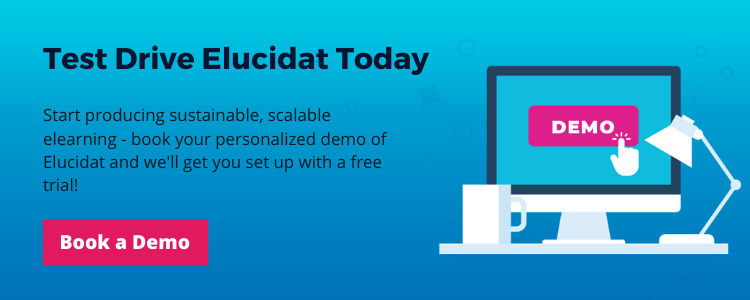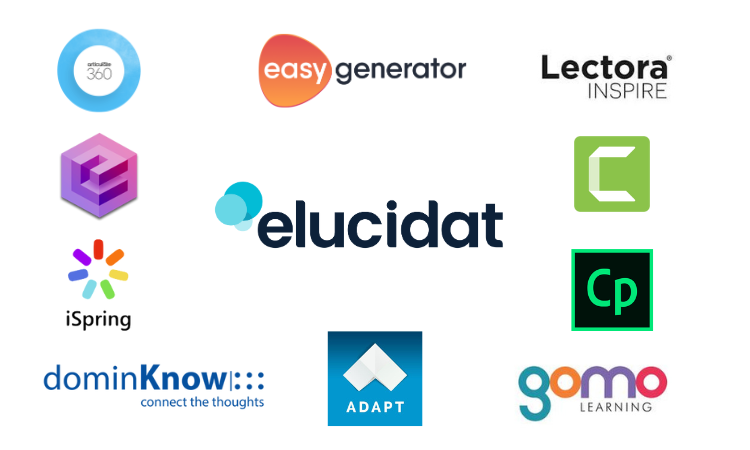Software reviews: Storyline 360, Rise 360 and Elucidat
8 minute read
Storyline 360, Rise 360, and Elucidat remain three of the most popular elearning authoring tools on the market. All three let content authors create great-looking online courses, but there are some differences in how they work and what they can offer. Let’s see how they compare.
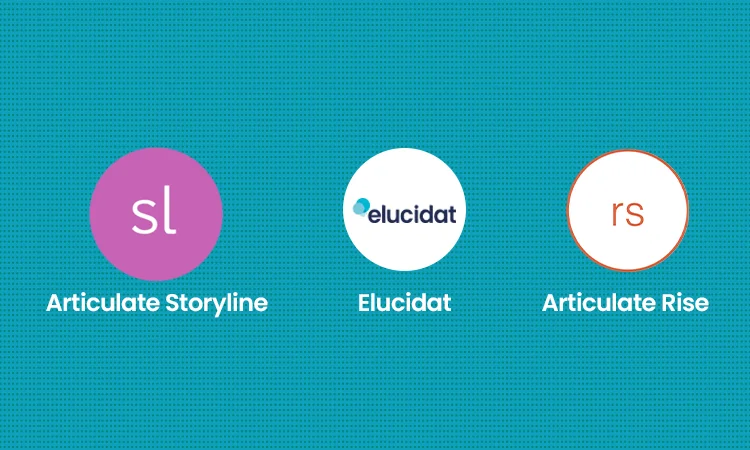
How will we compare the three authoring tools?
We will be reviewing each tool from five angles: ease of use, quality output, production speed, scalability, and who it’s best suited to. The table below captures a snapshot of this information.
| Storyline 360 | Rise 360 | Elucidat | |
| Type of solution | Desktop authoring tool | Online authoring tool | Online authoring platform |
| Ease of use | Hard | Easy | Easy |
| Output quality | High | Medium | High |
| Production speed | Slow | Fast | Fast |
| Scalability | Low | Medium | High |
| Best suited for | Users familiar with PowerPoint and linear content, who want to add more complex features. Experienced Storyline users. | Users who want to build simple modules quickly and easily – typically small organizations. | Large employers looking to reduce costs and create high-quality courses quickly and effectively at scale. |
| Price | $1,399 cost per user for annual Articulate 360 subscription | $1,399 cost per user for annual Articulate 360 subscription | Contact us for pricing – Elucidat becomes competitive for teams of 5+ authors. |
Elucidat review
What is Elucidat?
Elucidat is a multi-award winning elearning authoring tool that enables you to produce high-quality online courses at scale. It includes its unique Guided Authoring workflow, which empowers authors of all abilities to create fully responsive courses quickly and easily.
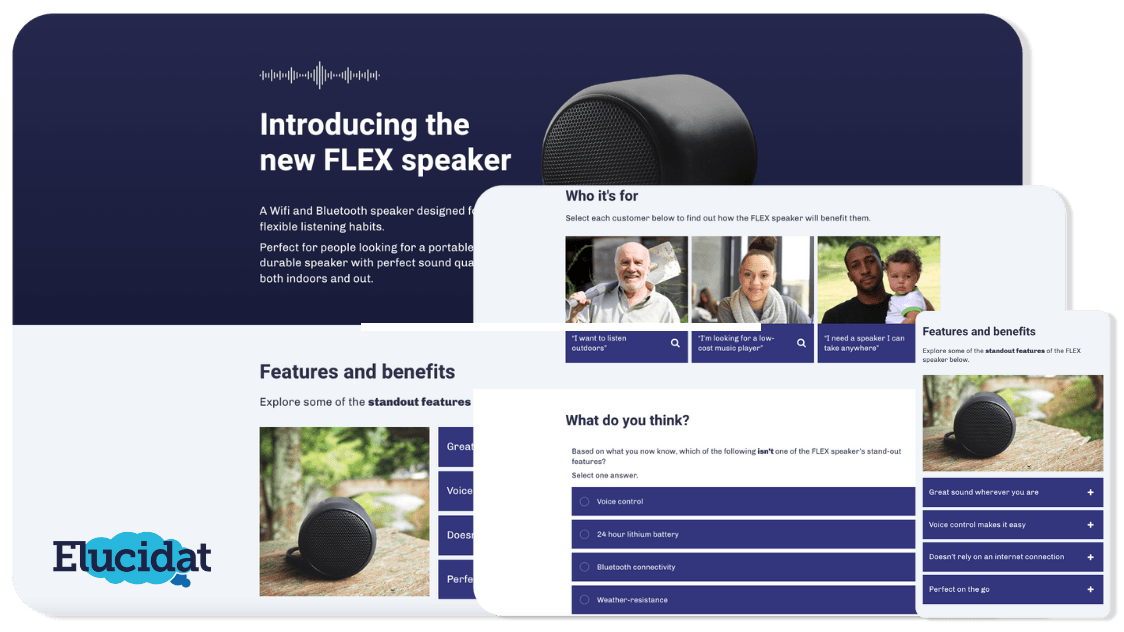
Ease of use
There are different options for building content in Elucidat: you might choose to use expert-designed templates from Learning Accelerator, which come with downloadable storyboards and in-line design guidance. Alternatively, you can use Guided Authoring to create custom, on-brand templates yourself for your team to use. (See how nCino have used it).
Whichever you choose, you’ll have access to Elucidat’s industry-leading Support team. And because Elucidat uses a what-you-see-is-what-you-get interface and supports responsive authoring, you can see exactly how your course is going to look as you build it, and on any device.
Production speed
Elucidat allows you to add, duplicate, and move pages within your project quickly and easily. For an extra swift turnaround, using the Learning Accelerator means you can create and publish courses four times faster than before.
Collaboration between team members is seamless. With cloud-based authoring, you can invite reviewers to add comments directly to content within the platform and be sure that any amends they make are fed straight through to a central version.
Maintenance time is also minimized, as any updates you need to make on your live courses can be actioned without reuploading the SCORM files.
Scalability
With Learning Accelerator, L&D teams can involve their subject matter experts (SMEs) in course creation, without requiring training, meaning higher production rates.
To maximize efficiency when working at scale, Elucidat makes it easy to set up your Brand Style and then re-use it across projects. You also have the option to set up a Parent Course as a template to seamlessly create localized versions of content, that you can update quickly using the Variations Manager functionality.
Managing assets across your courses is simple; the centralized asset library allows you to build your media repository as you go, so you can easily re-use videos and images later on. Even better, you can instantly update the same asset used across 100s of courses with mass updates.
What’s more, when it comes to collaboration, Advanced User Management allows you to customize the default User Roles and even create your own, allowing your teams to work to their strengths and giving you complete control when managing collaboration across courses.
Who it’s best suited to
Elucidat is ideally placed to help content authors who need to create elearning as part of a team and roll it out to large numbers of learners.
Main pros and cons of Elucidat
| Pros | Cons |
|
|
Storyline 360 review
What is Storyline 360?
Storyline 360* is a desktop tool that uses a PowerPoint-style slide-based approach to elearning development. It’s purchased as part of the Articulate 360 suite.
*Note that Storyline 3, which was previously offered as a standalone version of Storyline, is no longer receiving updates from Articulate. Customers must use Storyline as part of the Articulate 360 suite to access ongoing product updates.

Ease of use
Creating a very basic course in the Storyline 360 tool will be easy for many authors, particularly those familiar with its PowerPoint foundations. Slide templates selected from the inbuilt Content Library 360 are a simple way to get started.
However, Storyline’s most interesting features are more complex to create. Also, whilst the responsive player does ensure content will be resized for mobile devices, the experience won’t be optimized for these users, simply shrunk down to fit the screen.
Quality output
Pretty much any type of interaction can be created in Storyline 360, it’s just about taking the time to learn the ropes. What’s more, the tool allows you to create screencasts, software simulations, and animation effects.
Production speed
The publication of elearning is as quick as a click of a button, but creating courses is likely to require a time investment while authors get accustomed to the tool. Also, because Storyline 360 is not cloud-based, authors can’t work on courses at the same time.
Storyline 360 users can benefit from the embedded Content Library 360, which means you can source generic royalty-free images without leaving the tool.
Scalability
The Slide Masters feature allows you to create various layouts and assign them to slides with certain types of content, supporting the development of large projects.
However, working at scale can be hindered by the steep learning curve that authors need to master, and the fact that updates and collaboration aren’t supported by the cloud, which can slow down production and increase room for error.
Who it’s best suited to
Articulate Storyline is a good option for content authors who want custom interactions and have the time to invest in creating these from scratch.
| Pros | Cons |
|
|
Rise 360 review
Rise 360, also part of Articulate 360, is a web-based authoring tool that lets novice authors build basic courses using a range of pre-built “blocks.”
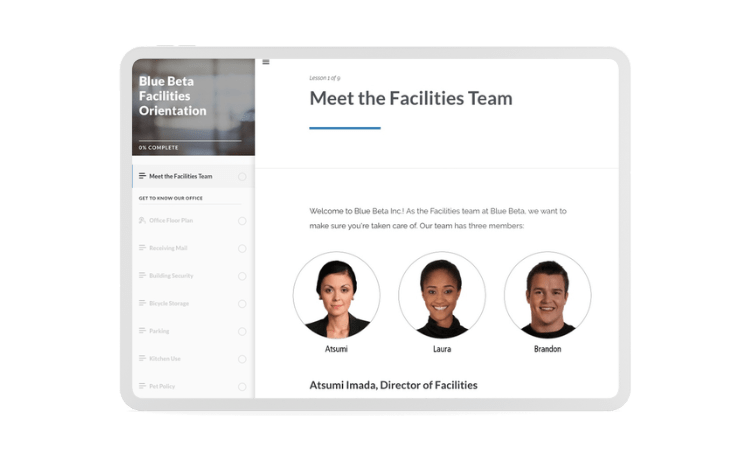
Ease of use
Basic authoring in Rise 360 is easy. You can apply prebuilt and customizable course themes and then add, edit, and drag and drop block templates to build your training. When you’re done, you can preview your lessons or courses to see how they will look on a desktop, tablet, or mobile device.
However, the interface is not available in multiple languages, meaning all authors and reviewers need to be English-speaking.
Quality output
Courses with Rise 360 are clean, clear and simple. The tool offers a decent range of standard interactions, including interactive sorting, timelines, flashcards, quizzes and scenario blocks, that fit the bill for some elearning courses.
However, there is very little flexibility beyond these, and limited scope for tailoring page layouts. This means it’s harder to fully customize a course to meet specific needs, and the learning experience from one course to another can start to feel quite similar. A way around this is to publish a Storyline 360 project to Articulate 360, then import it into a Rise 360 blocks lesson but this results in a disjointed learner experience.
Production speed
The speed and efficiency of creating courses with Articulate Rise is its main selling point. You can use simple block templates to build up your course quickly and access the inbuilt Content Library 360 to select and embed generic assets.
Scalability
Courses built in the Rise authoring tool can be cloned and reused, so a standard design setup can be used for multiple courses. Also, unlike Storyline 360, Articulate Rise is a cloud-based tool, so multiple content authors can work on the same course at the same time.
The main drawback of using Rise 360 to create courses at scale is that the learning experiences may start to feel quite repetitive to your audience.
Who it’s best suited for
Given its easy-to-use interface and cloud based capabilities, Rise 360 is best suited to small organizations looking to turn out courses quickly, without having to spend time learning how to use the tool or managing content uploads and downloads.
Main pros and cons of Rise 360
| Pros | Cons |
|
|
Elucidat alongside Articulate
If there isn’t one tool available that does everything the way you need it to, your L&D team might consider multiple subscriptions.
What would you use each tool for?
Elucidat works well for most elearning design needs. Other tools like Storyline 360 can complement an all-round tool like Elucidat for things like systems training or advanced assessments.
How Elucidat covers the Articulate 360 gap
Storyline 360 has the greatest flexibility and scope for creating bespoke interactions. However, it comes with a steep learning curve and because it’s a desktop tool, working at scale can be challenging. Rise 360, on the other hand, is cloud-based and very simple to use, but this can come at the expense of the learner experience.
Elucidat meets you in the middle, allowing authors to easily create high-quality, wide-ranging learning experiences, without time spent learning the ropes.
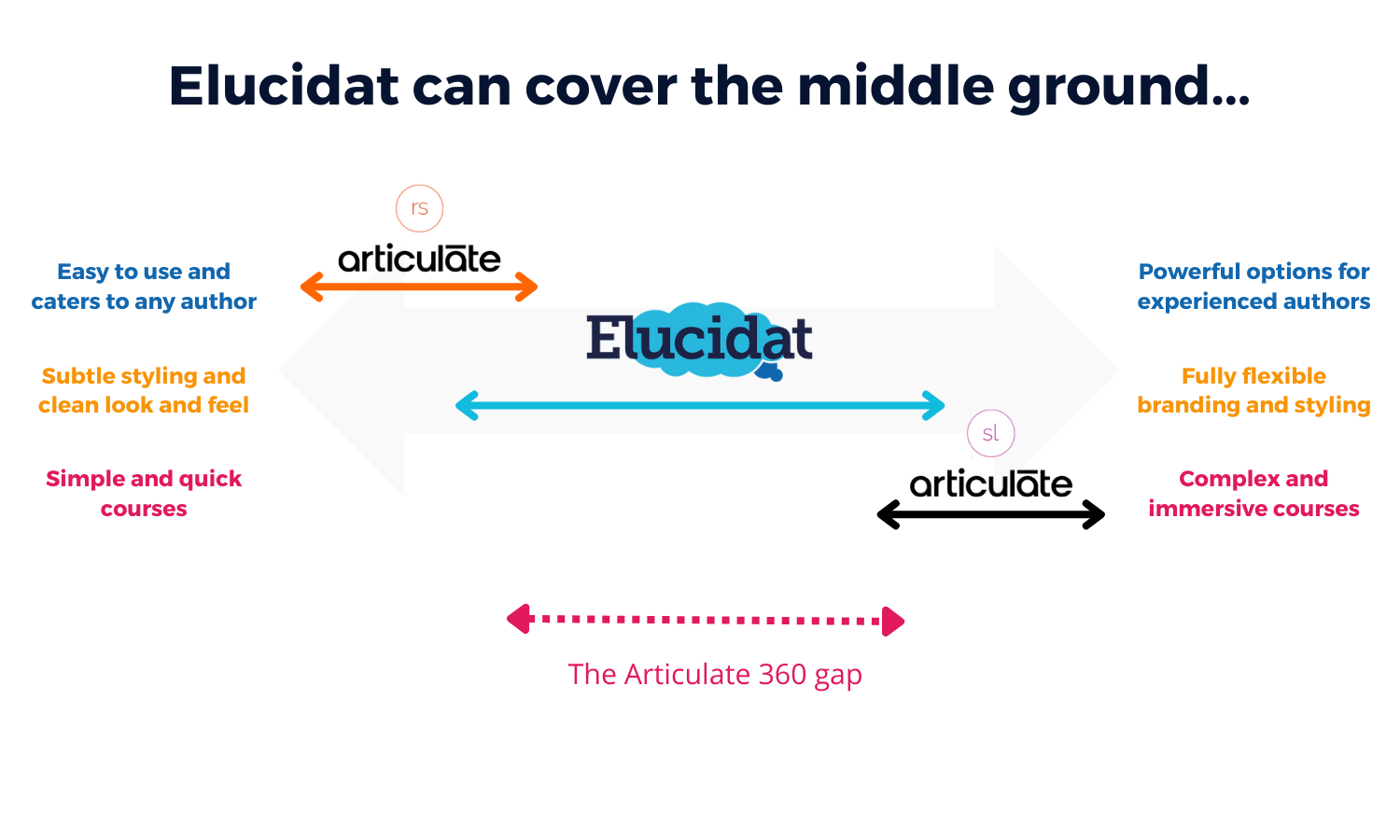
Final thoughts
Elucidat can be considered a suitable option for large organizations, looking to expand their authoring teams and turnout high-quality courses quickly, as their business responds to change.
However, if your L&D teams have complex and multifaceted requirements, you might consider combining Elucidat and Articulate 360 subscriptions to cover all bases.
Explore Elucidat
Find out how you can produce sustainable, scalable elearning with Elucidat. Book a personalized demo with one of the team, and start a free trial.
Co-written by: Lauren Keith, Senior Learning Designer.

